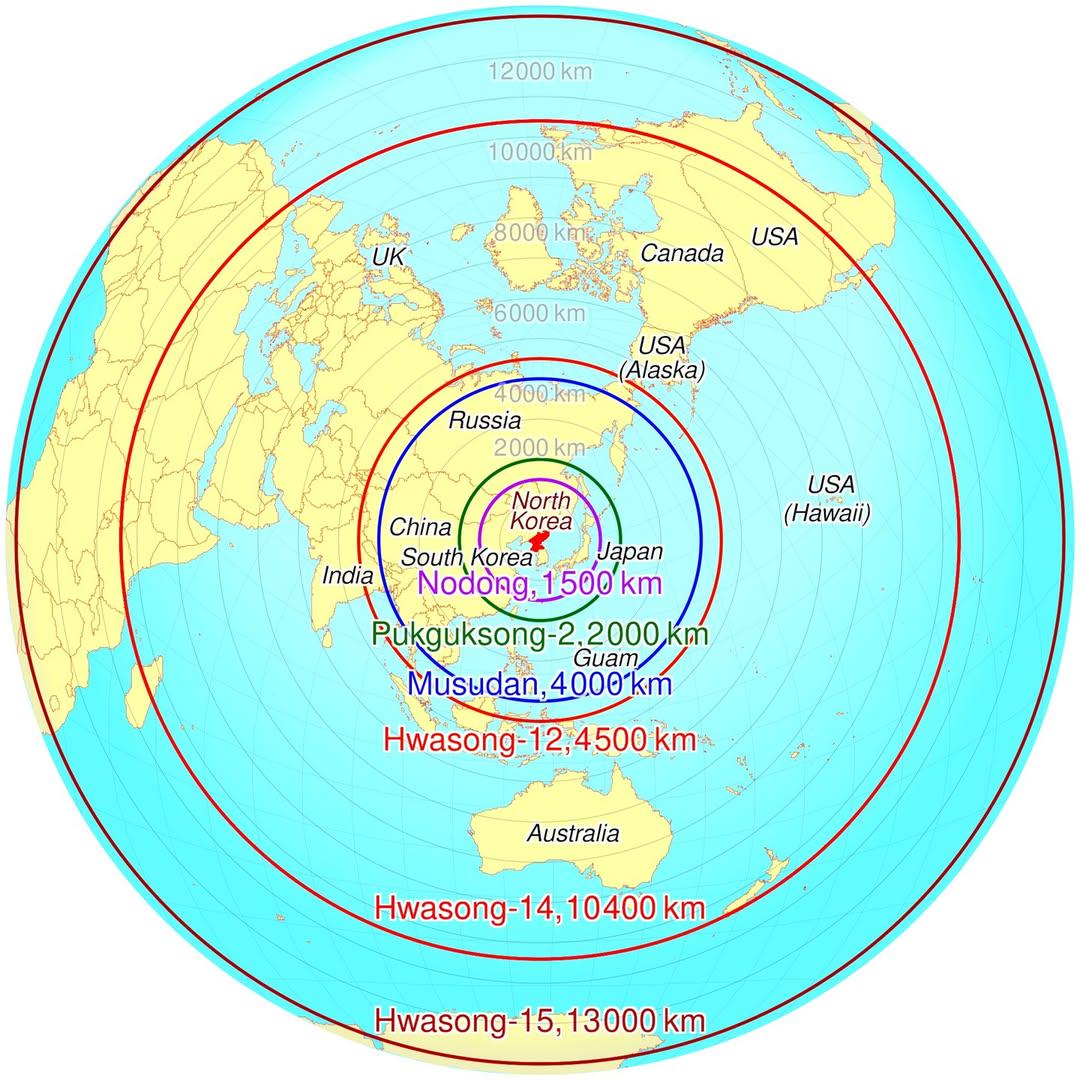Estimated Maximum Ranges of North Korea's Missiles Map


David Chen
Data Visualization Specialist
David Chen is an expert in transforming complex geographic datasets into compelling visual narratives. He combines his background in computer science ...
Geographic Analysis
What This Map Shows
This map illustrates the estimated maximum ranges of North Korea's missile capabilities, providing a visual representation of how far these missiles could potentially reach. It highlights the geographical areas that are within striking distance of North Korean missile launches, indicating both regional and global implications. Understanding these ranges is crucial for evaluating the security landscape in Northeast Asia and beyond, especially considering the geopolitical tensions surrounding North Korea's military ambitions.
Deep Dive into North Korea's Missile Capabilities
North Korea has made significant advancements in its missile technology over the past few decades. The country is known to possess a variety of missile systems, including short-range, medium-range, and intercontinental ballistic missiles (ICBMs). The key to understanding the implications of this map lies in recognizing the distinct categories of missiles and their respective ranges.
Short-range ballistic missiles (SRBMs) are designed for quick strikes against targets within a radius of approximately 1,000 kilometers. This range covers most of South Korea and parts of Japan, making these missiles a direct threat to the region. Interestingly, the North Korean military has conducted numerous tests of SRBMs, demonstrating both their operational readiness and the country’s commitment to maintaining a credible deterrent against perceived threats.
Medium-range ballistic missiles (MRBMs) extend the reach further, with ranges typically between 1,000 and 3,500 kilometers. This category includes missiles capable of striking major cities in Japan and parts of Southeast Asia, enhancing the strategic reach of North Korea's military capabilities. The Hwasong-12, for example, is a notable MRBM that has been tested with varying success and is designed to target U.S. military installations in the region.
However, the most alarming threats come from North Korea's development of intercontinental ballistic missiles (ICBMs), which can travel distances exceeding 5,500 kilometers. The Hwasong-15, for instance, is believed to be capable of reaching the continental United States. The implications of this capability are profound, as it introduces a new level of strategic deterrence that affects global security dynamics.
In recent years, North Korea has also focused on enhancing the accuracy and reliability of its missile systems. The development of multiple independently targetable re-entry vehicles (MIRVs) could allow a single missile to carry multiple warheads, significantly complicating any defensive measures that might be employed by adversaries. This advancement raises important questions about the efficacy of missile defense systems, particularly those in South Korea and Japan.
Regional Analysis
Taking a closer look at the regions shown on the map, we can assess how the estimated missile ranges impact different areas. For instance, South Korea is predominantly within the short-range category, illustrating a constant state of vigilance and defense preparedness. The proximity of major urban areas such as Seoul to North Korean missile ranges means that any conflict could escalate rapidly, leading to devastating consequences.
Japan, while slightly further away, still finds itself within the crosshairs of North Korea's MRBMs. The island nation has been actively engaged in strengthening its defense capabilities, including missile defense systems such as Aegis and THAAD. The Japanese government’s response to North Korean missile tests has often included diplomatic efforts alongside military preparedness, highlighting the delicate balance of power in the region.
Interestingly, the potential reach of ICBMs also brings global powers into the equation. The estimated ranges indicate that parts of Alaska and the west coast of the United States could be at risk from North Korean missile strikes. This reality has led to increased scrutiny and response strategies from U.S. military officials, as well as discussions regarding the implications for national security policy.
Significance and Impact
Understanding the estimated maximum ranges of North Korea's missiles is not just about geography; it holds significant implications for international relations, security policies, and military strategies. The map serves as a stark reminder of the ongoing tensions on the Korean Peninsula and highlights the importance of diplomatic efforts to mitigate conflict.
As North Korea continues to develop its missile technology, the international community must remain vigilant. The potential for miscalculation or accidental conflict increases with each missile test, making it essential for nations to engage in dialogue and establish clear communication channels.
In conclusion, the map of North Korea's missile ranges encapsulates a critical aspect of modern geopolitics. It emphasizes the need for comprehensive strategies that address both the military and diplomatic dimensions of security in Northeast Asia and beyond. As we move forward, the world must grapple with the complexities of deterrence, diplomacy, and the ever-evolving landscape of international relations.
Visualization Details
- Published
- August 10, 2025
- Views
- 186
Comments
Loading comments...